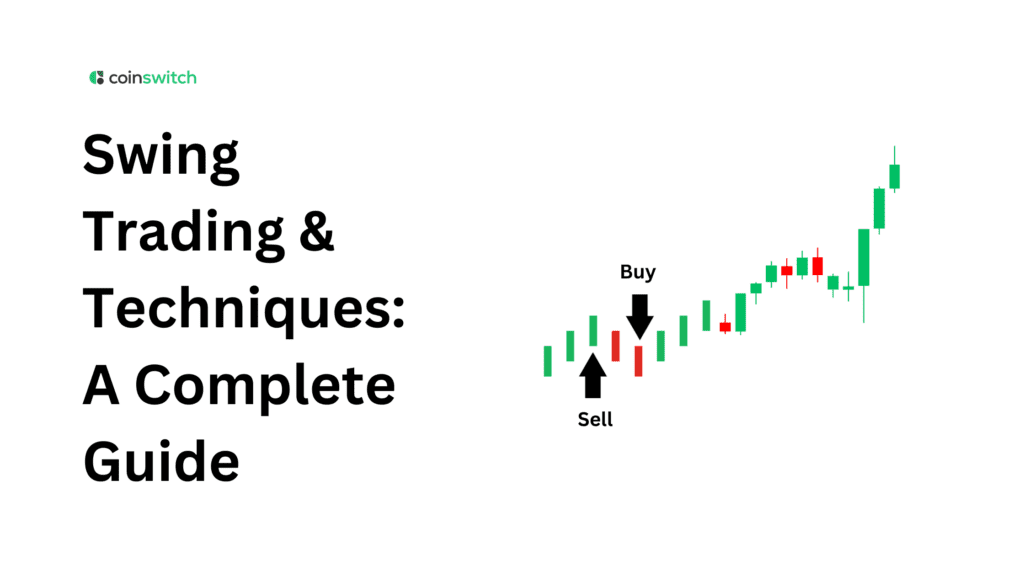Timing the market is passe, time in the market is in. If you are familiar with crypto trading strategies, you might have come across the term swing trading—a crypto trading strategy popular among crypto traders.
Swing trading employs technical tools like oscillators, support and resistance levels, and chart patterns to determine when to enter and exit. Risk management is important since position size restrictions and stop losses are good ways to reduce losses. Swing traders look for profits that are much higher than possible losses and often look for good risk-to-reward ratios.
If done well, this method can provide stable, medium-term gains, but it requires dedication and the ability to think critically. To understand this better, one needs first to learn what swing trading is? It combines systematic risk management with technical analysis to track price changes that happen over the course of many days to weeks.
What Is Swing Trading?
Swing trading, as the name suggests, is a crypto trading strategy that capitalizes on market swings or market volatility. It involves swinging from buying to selling at lows and highs of the market for a relatively short period, ranging from a few days to weeks.
Technical analysis is a big part of swing trading. Traders use moving averages, momentum oscillators like RSI or MACD, chart patterns like flags and double tops or bottoms, and support and resistance zones to determine when the best periods are to buy and sell. For instance, swing traders might trade breakouts when the price breaks through key resistance levels or enter on a retreat when the trend is strong.
It’s also vital to know how to handle risks. Swing traders use stop-loss orders and seek the right risk-reward ratios to make sure that they win more trades than they lose. Swing trading is flexible, and if you execute it with discipline and balance short-term transactions with long-term investments, you may make a lot of money.
Read More: Momentum Trading Explained: A Basic Guide
Understanding Swing Trading
Finding and taking advantage of short- to medium-term movements in the market is what swing trading is all about. This technique is ideal for those who don’t have the time to monitor the markets since it lets them trade in the short term and invest in the long run. Traders use technical analysis to determine when it is ideal to buy and sell. Technical analysis employs tools such as moving average indicators, support and resistance levels, momentum oscillators, and candlestick patterns.
Candlestick patterns like engulfing patterns, hammers, and dojis might show that a trend could change or continue. You can use these patterns to gauge the market’s performance. Oscillators help validate changes in momentum and discover markets that are too far gone or starting to turn around.
It’s still necessary to keep an eye on the risks involved. Traders use stop-loss orders and cautious position allocation to keep their money safe. This makes sense and keeps you from making choices depending on how you feel.
Swing trading primarily involves employing a combination of chart-based methods and precise execution to profit from significant price movements. It provides traders with flexibility without compromising quality. This is a planned and well-balanced approach when used with good communication and risk management.
Swing Trading Strategies
In swing trading, traders typically look for good opportunities by using technical indicators. They might play reversals at important levels, follow the existing trends, or get in after a breakthrough. These tactics help you combine flexibility in changing markets with a plan for execution.
Entries that Follow Trend
Traders who follow the momentum of a trend that has already been set frequently wait for a little break before getting in. They utilize moving averages or trendlines to check if the trend is still going. They initiate trades based on the current market trend after seeing a retracement so that they can plainly and consistently observe price fluctuations.
Breakout Tactics
Traders look for swings that go over technical limitations or levels of consolidation so they may take advantage of changes in momentum. Triangles, flags, and trendlines are some visual tools that might help you find these breaks. After gaining confirmation, traders enter the market to take advantage of the expected price rise. This is usually supported by higher market volume or momentum indicators that match the break.
Reversal Plays
This method says that after a long time of price movement, either by purchasing too much or selling too much, the price will shift direction. Traders use the RSI, candlestick patterns, and oscillator divergences to find out how weary the market is. They open positions in the belief that the market will change when indications line up with crucial turning points, and they protect themselves by being vigilant with their risk management.
Read More: Positional Trading Strategy: Definition, Pros & Cons
Example of Swing Trading
You may want to try hypothetical swing trading with a renowned tech stock. For example, the shares that formed a cup-and-handle pattern between two price levels were clearly a bullish continuation pattern. When a resistance breakout develops near the handle, a trader who understands how to detect trends will seek the stock to close above the rim of the handle on higher volume. They begin the transaction as soon as it occurs and put a stop-loss right below the pattern’s bottom.
The price progressively rises as the transaction continues until it hits the first profit objective, which is around 10% higher than the price at which the trade was entered. After employing a trailing indicator like a moving average to lock in gains over time, the trader sets the stop at breakeven and lets the profits run. The stock ultimately drops below the moving average, which means it is weak. The trader leaves after seeing a huge swing move.
The trader did an excellent job of going with the flow of the market. Disciplined execution made this feasible. It included a clear entry on breakout, a stop-loss setup to restrict risk, and trailing stops to manage gains. Swing trading is a method that uses risk-reward awareness, strict stops, and pattern identification to produce outcomes that are easy to forecast. This is similar to numerous real-life cases that have been written about in trade books.
Pros and Cons
Swing trading presents notable disadvantages alongside its advantages. Swing trading captures short-term market movements over several days, making it essential to understand this approach. This approach may generate significant gains from short-term trends and requires less ongoing monitoring than day trading. However, it requires emotional control and exposes traders to overnight risk.
Pros
Less Time-Intensive than Day Trading
Swing trading offers significant benefits. Swing trading captures short-term market movements over several days, so understanding this approach is essential. This approach generates significant gains from short-term trends and requires less ongoing monitoring than day trading.
Potential for Higher Profits from Momentum
Swing trading offers greater returns per transaction compared to intraday tactics by capturing full market movements over days and weeks. Traders can profit from intermediate trends that develop over multiple sessions due to these fluctuations. Disciplined swing trading can effectively compound gains when combined over time.
Anchored in Technical Strategy
Moving averages, chart patterns, and indicators play a crucial role in swing trading. This technique helps promote objective decision-making efficiently. Traders remain consistent and disciplined as they have predetermined trade settings, making them less vulnerable to wanton emotional whims.
Cons
Overnight and Weekend Risk
Swing traders face gaps and news risk outside of trading hours when they hold positions for several days. Unexpected occurrences or statements made after hours can lead to significant price movements that erase prearranged stop levels. This sensitivity increases total risk compared to intraday trading.
Requires More Time than Long-Term Investing
Swing trading demands less time than day trading, yet it requires frequent chart analysis, pattern detection, and strategy modifications. Besides, this level of engagement surpasses the passive nature of long-term investing, making it unsuitable for those who favor a hands-off approach.
Potential for Emotional Challenges
Traders may disregard their plan-based strategy, cling to losses in hopes of a turnaround, or exit their winnings too soon. Without discipline and a clear strategy, emotional reactions can reduce profits. Therefore, strict self-control and adherence to plans are essential for swing trading.
The Bottom Line
Swing trading focuses on capitalizing on intermediate-term price movements while managing the market’s natural ebb and flow. It provides the benefit of exercising technical discipline, making smart entries, and managing risk effectively, which makes it valuable for both part-time and full-time traders. Although it demands constant care, its systematic settings help maintain control and uniformity.
Swing trading presents its own hazards, including overnight exposure and emotional challenges. To achieve success, implement a sound trading strategy, execute methodically, and continuously learn and adapt. Additionally, swing trading can be a valuable and flexible addition to a trader’s portfolio if executed correctly.
FAQs
1. What is the 2% rule in swing trading?
The 2% rule caps the risk tied to a single trade at a maximum of 2% of total trading capital. The loss can’t exceed the cap if the transaction hits a stop-loss. This will protect the trader’s capital from large losses.
2. What is the 3-5-7 rule in trading?
The rule goes something like this: Not to risk more than 3% of your trading capital on any single trade; limit your overall exposure to 5% of your capital on all open trades combined; and make sure that your winning trades are at least 7% more profitable than your losing trades.
3. What is the 1% rule in swing trading?
The 1% rule is a conservative risk management strategy in swing trading. Here, traders risk only 1% of their total capital on any single trade.
4. What is the best method for swing trading?
Successful swing trading involves a disciplined risk management style, a personalized trading strategy, and consistently taking actionable technical analysis. Analyzing pullbacks, breakouts, and chart patterns, just to name a few. There is no best way to swing trade. The best traders assess the market conditions, manage risk per trade, and backtest their trading strategy. Consistency and personal fit matter greatly.








